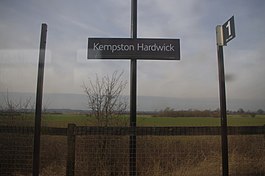Kempston Hardwick railway station
Kempston Hardwick railway station serves the village of Kempston Hardwick in Bedfordshire, England. It is not to be confused with the nearby town of Kempston. The station has two platforms next to a half-barrier level crossing.
| Kempston Hardwick | |
|---|---|
 Station signage in 2012 | |
| Location | |
| Place | Kempston Hardwick |
| Local authority | Bedford |
| Coordinates | 52.092°N 0.504°W |
| Grid reference | TL025447 |
| Operations | |
| Station code | KMH |
| Managed by | London Northwestern Railway |
| Number of platforms | 2 |
| DfT category | F2 |
| Live arrivals/departures, station information and onward connections from National Rail Enquiries | |
| Annual rail passenger usage* | |
| 2014/15 | |
| 2015/16 | |
| 2016/17 | |
| 2017/18 | |
| 2018/19 | |
| History | |
| 1905 | Opened as Kempston Hardwick Halt |
| 1 January 1917 | Temporarily closed |
| 5 May 1919 | Reopened[1] |
| 15 July 1968 | Became unstaffed[2] |
| National Rail – UK railway stations | |
| * Annual estimated passenger usage based on sales of tickets in stated financial year(s) which end or originate at Kempston Hardwick from Office of Rail and Road statistics. Methodology may vary year on year. | |
Kempston Hardwick is the least used station in Bedfordshire.[3]
Services
Kempston Hardwick is served by West Midlands Trains (previously London Midland), using Class 230/0 multiple units. One service runs each hour in either direction (except Sundays).[4] The running line through this area has been upgraded to enable the speed limit for passenger trains to increase from 40 to 60 mph.
| Preceding station | Following station | |||
|---|---|---|---|---|
| London Northwestern Railway Marston Vale Line Mondays-Saturdays only |
Community Rail Partnership
Kempston Hardwick station, in common with others on the Marston Vale Line, is covered by the Marston Vale Community Rail Partnership,[5] which aims to increase use of the line by involving local people.
History
The level crossing at Kempston Hardwick was opened in 1846 with the construction of the Bedford Railway Company railway line between Bedford (St Johns railway station) and Bletchley.
An agreement with the London and Birmingham Railway was made whereby the railway was to be constructed and operated by the London & Birmingham Railway company, who under the terms of "The Bedford and the London and Birmingham Railway Act 1846" split the profits from the operation of the line. During the construction of the line however the London and Birmingham Railway merged with the Grand Junction Railway to form the London and North Western Railway company.
Kempston Hardwick was one of three halts opened by the London and North Western Railway in 1905 between Stewartby and Bedford. Their opening coincided with the introduction of a steam railmotor on the Varsity Line; the station platform initially consisted of wooden sleepers laid at ground level for a carriage length.[6] All three closed as a wartime economy measure during the First World War and two were closed during Second World War, never to reopen, leaving Kempston Hardwick as the only survivor. Its survival can be attributed to its convenient location for the nearby Eastwood's Brickworks which was served from 1928 by a private siding on the up side of the line.[7]
The level crossing alongside the station was once controlled by a crossing keeper who lived in a lodge adjacent to his place of work. This was demolished in the 1980s.
In 2003, it was reported that Kempston Hardwick was one of the quietest stations in England as only 38 passengers per month were reported to be using it. Two reasons offered for the lack of custom were the absence of signage indicating the station from the main road, and the lack of parking facilities.[8] Following the release of this story, Silverlink together with Bedfordshire County Council confirmed that they would not be seeking the closure of the station.[9] Station patronage has, however, now increased, according to the Community Rail Partnership which attributes the rise to the creation of significant numbers of jobs in the area.[10] In 2008, it was announced that the area around the railway station could be the location of a new eco-town.[11]
| Preceding station | Disused railways | Following station | ||
|---|---|---|---|---|
| Wootton Broadmead Halt | British Railways Varsity Line |
Kempston and Elstow Halt |
References
- Butt, R.V.J. (1995). The Directory of Railway Stations. Sparkford: Patrick Stephens Ltd. p. 130. ISBN 1-85260-508-1.
- Clinker, C.R. (1978). Clinker's Register of Closed Passenger Stations and Goods Depots in England, Scotland and Wales 1830-1977. Bristol: Avon-AngliA Publications & Services. p. 164. ISBN 0-905466-19-5.
- "Estimates of station usage". Office of Rail and Road. January 2020. Retrieved 25 January 2020.
- Table 64 National Rail timetable, May 2016
- Marston Vale Community Rail Partnership
- "Kempston Hardwick Halt". Community Archives. Bedfordshire County Council. Archived from the original on 29 August 2008.
- Simpson, Bill (1981). Oxford to Cambridge Railway. Poole: Oxford Publishing Co. p. 69. ISBN 0-86093-121-8.
- The Guardian, "Platform soul", 21 May 2003
- "Just one train passenger each day". BBC News. 12 May 2003.
- "Bedford to Stewartby". Marston Community Rail.
- "Executive Meeting" (PDF). Mid Bedfordshire District Council. 18 June 2008.
External links
| Wikimedia Commons has media related to Kempston Hardwick railway station. |
- Train times and station information for Kempston Hardwick railway station from National Rail
- Kempston Hardwick - Least Used Station in Bedfordshire 2019 YouTube video by Geoff Marshall about the station.